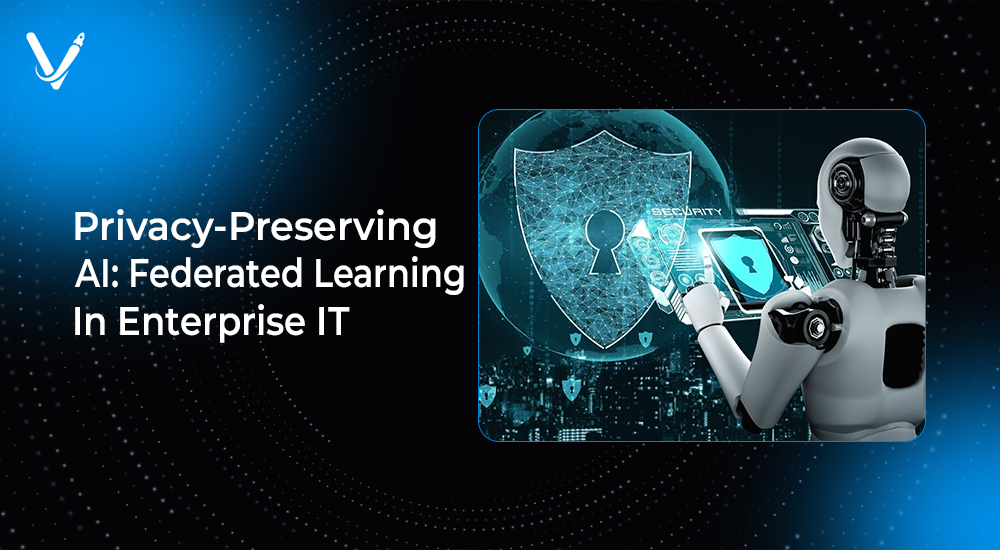Privacy-Preserving AI: Federated Learning in Enterprise IT


- Sep 30, 2025
Enterprises want intelligent systems that adapt to real-world behavior while keeping sensitive records under tight control. Teams want predictive models that refine customer journeys, detect risk, optimize supply chains, and personalize experiences. Legal, security, and risk leaders want airtight governance, auditability, and minimal exposure of personally identifiable information. For years this tension pushed AI leaders toward heavy anonymization, synthetic data, or centralized data lakes guarded by strict access policies. Those approaches help, yet they still concentrate sensitive assets in one place and increase blast radius in case of compromise.
Federated learning offers a different path. Models travel to the data rather than transporting raw records to a central location. Training occurs where the data already lives—inside mobile devices, branch servers, hospital networks, retail stores, bank cores, industrial gateways, and enterprise laptops. Only learned signals, like gradient updates or model deltas, head back to an aggregator. Privacy techniques such as secure aggregation, differential privacy, and confidential computing further reduce exposure. With the right architecture, teams gain modern AI capability without uprooting data estates.
This guide unpacks how federated learning works in enterprise IT, what value it unlocks, and how to deploy it with security, compliance, and MLOps discipline. You’ll see practical use cases, architecture patterns, pitfalls to avoid, and a step-by-step playbook leaders can follow. The tone is pragmatic: less hype, more implementation detail, designed for practitioners who need results with guardrails intact.
Centralizing sensitive datasets creates operational friction. Data stewards must approve complex access pathways. Legal teams must validate consent, purpose limitation, and retention. Security teams must harden storage, movement, and monitoring. Meanwhile, product and analytics teams still need fresh signals to keep models useful. Every day that goes by with stale training data widens the gap between live behavior and what a model actually sees.
A privacy-preserving approach seeks to keep data resident in its original environment while still enabling learning. Instead of pulling all records into one location, the system sends a training task outward to many participating nodes. Each node trains locally on its own dataset, computes a model update, and contributes only those learned parameters to a central aggregator. The aggregator combines many small updates into a global model. This cycle repeats, gradually improving quality while reducing exposure. In effect, AI learns at the edge and synchronizes knowledge without pooling raw records.
Think of a global model as a recipe that improves with feedback. The central service shares a starter recipe with many kitchens. Each kitchen tweaks the recipe using its own taste tests. No one ships original ingredients anywhere. Only the tweaks travel back. The central service blends those tweaks to revise the recipe and shares the updated version again. Iteration continues until the recipe tastes great to diverse palates.
In technical terms:
That’s the core concept: ship learning tasks outward, keep raw data in place, share only learned signals.
Federated learning is a coordination pattern. Its privacy posture depends on additional techniques that guard each step of the pipeline.
Even if individual updates are not raw records, they can leak information if handled naively. Secure aggregation ensures the server only sees an aggregate—never a single client’s contribution in the clear. Clients mask their updates using cryptographic schemes so the server can combine masked values into a valid sum, without learning any one client’s raw update.
Differential privacy (DP) injects carefully calibrated noise into updates so that an observer cannot confidently infer anything specific about a single individual. DP offers a measurable privacy budget (often denoted by epsilon) that quantifies privacy loss. With DP, even a compromised aggregator gains limited insight about any one user or branch.
Trusted Execution Environments (TEEs) such as Intel SGX or ARM TrustZone can run aggregation inside hardware-enforced enclaves. Attestation proves enclave integrity, while memory encryption protects sensitive material during processing. TEEs pair well with secure aggregation, adding an extra protective shell around the aggregation logic.
Homomorphic encryption allows computation on ciphertext, enabling aggregation without decryption. Secure multiparty computation (MPC) splits secrets across collaborators so no single party holds the full key. These approaches add strong guarantees, at the cost of additional compute overhead.
Private set intersection (PSI) lets two parties compute intersections of identifiers without revealing anything else. When combined with pseudonymization of event streams and network-level anonymity (e.g., onion routing for update traffic), it becomes hard to re-identify or track clients during training.
Finally, the basics still matter: enforce strict egress controls, log every training call, rate-limit update frequency, and store only what is required for observability. Privacy preservation is a system property, not a single feature.
Federated learning is not one architecture; it is an adaptable pattern. Enterprises mix and match patterns depending on data gravity, networking, and regulatory scope.
A strong MLOps foundation separates successful deployments from lab experiments. Federated learning adds complexity to that foundation.
Privacy-preserving AI should align with regulatory expectations about purpose limitation, data minimization, transparency, and security.
Hospitals want AI that detects risk factors, predicts no-shows, triages radiology queues, or flags dosage anomalies. Moving clinical records out of protected networks introduces risk and legal hurdles. With federated learning, a hospital network can train models across sites while keeping charts, images, and notes in place. Only masked updates leave the site. Combined with DP, the exposure profile drops sharply.
Banks can improve fraud detection and anti-money-laundering signals using behavioral patterns gathered across branches and digital channels. Federated learning enables model refinement inside branch cores and secured VPCs without exporting transaction details. Aggregation can run inside confidential compute nodes with audit trails for regulators.
Regional pricing, inventory behavior, and promotion response vary widely. Training locally in stores and point-of-sale systems captures these nuances. Updates synchronize to a global model that remains sensitive to local patterns. This avoids broad data pooling while still improving recommendations and demand forecasting.
Industrial equipment generates plentiful telemetry. Sending every log to a central service is expensive and slow. On-prem gateways can train models on vibration, temperature, and throughput to predict downtime and optimize maintenance. The global model learns across plants via secure update exchange.
Base stations and edge CSP nodes see unique traffic profiles. On-site training captures those profiles for dynamic capacity planning, quality of experience improvements, and anomaly detection. Updates flow into regional aggregators that refine a network-wide model without exporting subscriber records.
Workforce analytics and talent engines must respect employee privacy. Client-side analytics inside enterprise devices can learn patterns that improve scheduling, burnout detection, or learning recommendations. Updates sync to a central coordinator that never sees individual activity logs.
Sending updates is cheaper than shipping entire datasets, yet still non-trivial at scale. Use compression, sparsification, and quantization to shrink updates. Consider update frequency schedules based on data change rate and business cycles.
Not every client participates in every round. Implement partial participation with randomized sampling. Handle stragglers gracefully so training continues even when some clients are offline.
Edge nodes vary widely. Offer multiple model variants or use techniques like knowledge distillation to adapt a heavy global model into lighter device-level models. On branch servers, leverage GPUs where available; otherwise use optimized CPU kernels.
Non-IID data—each client having a different distribution—can slow learning. FedAvg and its cousins handle a lot, but hyperparameter tuning becomes more delicate. Techniques such as adaptive learning rates, proximal terms, or personalized layers often help.
Budget across four buckets: on-device compute, network egress, secure aggregation/TEEs, and orchestration overhead. In many cases, reduced data transfer and lower central storage can offset edge compute costs, especially when edge hardware already exists.
Security posture depends on strong identity, attestation, secrets hygiene, and resilient handling of malicious clients.
One appeal of federated learning is personalization at scale. A global model captures shared patterns. Local fine-tuning layers adapt behavior to a region, device, or tenant. That layered approach preserves privacy while improving relevance. For example:
Personalization works best with careful evaluation to ensure local improvements do not degrade fairness or safety.
Decentralized learning can amplify or reduce bias. Success depends on cohort design, measurement, and governance.
Teams can assemble their own stack or leverage existing frameworks. Many leaders adopt a hybrid approach: use open-source frameworks for the orchestration core and integrate enterprise-grade privacy, identity, and observability components.
When evaluating vendors, look at integration with identity providers, auditability, DP configuration controls, and support for TEEs or MPC.
A successful rollout benefits when teams move through a clear sequence. Below is a pragmatic flow, expressed without numeric bullets to respect your formatting request.
Picture the system as concentric layers.
Client layer
Transport layer
Aggregation layer
Orchestration and registry
Observability and governance
A global retailer wants better on-site recommendations that respect regional habits. Large data exports face internal resistance due to privacy risk and data residency. The team designs a federated learning program.
Local training agents run in each store’s edge server. Nightly, when traffic is low, agents train on the day’s clickstream and transaction logs. Updates are compressed and masked, then transmitted to a regional aggregator running inside a confidential compute enclave. That aggregator applies secure aggregation and DP, producing a regional update. Regional updates roll up into a global model that captures broad shopping behavior without moving raw logs. In busy holiday periods, the coordinator increases local training frequency to keep pace with fast-changing patterns. If validation shows a dip in a specific region, the coordinator rolls back the model for that region while investigating. An internal governance council reviews privacy posture monthly, including DP budget consumption and enclave attestation reports. Store managers notice that results improve while privacy policies remain satisfied. Legal and security leaders support expansion across additional product lines.
Privacy-preserving AI, federated learning in enterprise IT, on-device learning, edge AI, secure aggregation, differential privacy, confidential computing, trusted execution environment, zero trust architecture, enterprise AI governance, data privacy compliance, GDPR alignment, HIPAA-ready AI, model governance, MLOps for federated learning, privacy-enhancing technologies, non-IID data, decentralized training, fairness in AI, responsible AI, DP budget, enclave attestation, encrypted model updates, retail edge AI, healthcare AI, financial AI, industrial IoT analytics.
Federated learning enables intelligent systems that respect boundaries. Models travel to data. Raw records stay put. Encryption, secure aggregation, differential privacy, and confidential computing create layered protection. With solid MLOps, rigorous governance, and fair evaluation, enterprises gain adaptive AI without widening exposure. The result is a practical path to personalization, risk detection, and operational efficiency that meets the standards of legal and security teams.
If you want to explore a pilot or scale an existing initiative, the team at Vasundhara Infotech can help architect and implement a production-grade federated stack with privacy-enhancing technologies aligned to your compliance landscape. Let’s design a roadmap, stand up a secure aggregator, deploy edge agents, and ship a model that learns safely in your environment. Reach out to schedule a discovery session with our AI architects.
Copyright © 2025 Vasundhara Infotech. All Rights Reserved.
